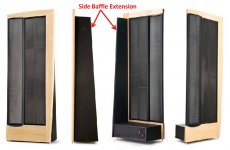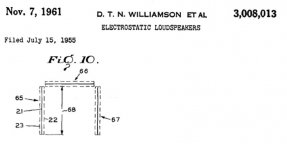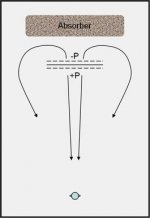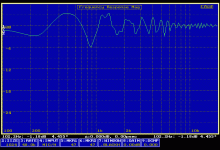Regarding bass on ESLs.
"Bass. At low frequencies, as wavelengths become large relative to panel width, the out-of-phase signals from opposite sides of the diaphragm tend to wrap around and cancel each other. So like all true dipole speakers (not to be confused with conventional-driver quasi-dipole surrounds), electrostatics are prone to weak bass. Increasing panel size helps with this, as well as with the output/efficiency problem discussed above, but there's a practical limit."
-Martin Logan website
Would it be possible to place lots of acoustic foam on one side of a electrostatic loudspeaker to absorb the out of phase signals?
Would that increase the bass or is there some problem that will crop up?
"Bass. At low frequencies, as wavelengths become large relative to panel width, the out-of-phase signals from opposite sides of the diaphragm tend to wrap around and cancel each other. So like all true dipole speakers (not to be confused with conventional-driver quasi-dipole surrounds), electrostatics are prone to weak bass. Increasing panel size helps with this, as well as with the output/efficiency problem discussed above, but there's a practical limit."
-Martin Logan website
Would it be possible to place lots of acoustic foam on one side of a electrostatic loudspeaker to absorb the out of phase signals?
Would that increase the bass or is there some problem that will crop up?
Regarding bass on ESLs.
Would it be possible to place lots of acoustic foam on one side of a electrostatic loudspeaker to absorb the out of phase signals?
Would that increase the bass or is there some problem that will crop up?
In general acoustic foam is not very affective at absorbing low frequencies, below about 300 Hz.
To block the out of phase bass from the rear of the ESL you pretty much have to use a physical barrier.
For their full range model Martin Logan adds a large baffle extension on the side nearest the bass panels to increase the bass output.
Adding an additional baffle extension on the other side of the panel would have increased the bass output further,
but the response and radiation pattern of the curved mid-treble panel would be adversely affected.
Also, with two large side baffle extensions, a cavity would be formed behind the panels which would potentially add an undesirable cavity resonance.
One other possibility was mentioned in the Williamson-Walker US patent 3008013:
Replace the baffle extensions with active ESL panels that are only driven at low frequencies where the phase cancellation is most problematic.
At higher frequencies, these panels will be essentially acoustically transparent so they will not induce a cavity resonance or adversely affect the mid-treble response.
Attachments
Last edited:
Hi,
as bolserst already said, foam layers of sufficient effectiveness would be of unpractical huge physical size and terrible optics too. But besides reducing the SPL on the foamed side this could lead to a positive shaping of the distribution character towards a ´kidney´. But still it wouldn´t help with the main problem, which is that an ESL is no good bass in first place.
jauu
Calvin
as bolserst already said, foam layers of sufficient effectiveness would be of unpractical huge physical size and terrible optics too. But besides reducing the SPL on the foamed side this could lead to a positive shaping of the distribution character towards a ´kidney´. But still it wouldn´t help with the main problem, which is that an ESL is no good bass in first place.
jauu
Calvin
What about installing a ESL panel in a wall?
The out of phase signals would be blocked by the wall.
The out of phase signals would be blocked by the wall.
Hi,
installing a panel into a wall would basically mean the same as to put a dynamic driver into a cloased box. But while the high mass of the drivers moving system leads only to an acceptable rise in resonance frequency the Fs of the ESL could rise undue high. Because of the diaphragm beeing virtually acoustically transparent utmost care needed to be taken that no internal reflected soundwaves could pass the membrane (something I dislike about the simple flat Beveridge casing). Peter Walker suggested rather deep shallow casings with lots of wadding and possibly open to the end.
jauu
Calvin
installing a panel into a wall would basically mean the same as to put a dynamic driver into a cloased box. But while the high mass of the drivers moving system leads only to an acceptable rise in resonance frequency the Fs of the ESL could rise undue high. Because of the diaphragm beeing virtually acoustically transparent utmost care needed to be taken that no internal reflected soundwaves could pass the membrane (something I dislike about the simple flat Beveridge casing). Peter Walker suggested rather deep shallow casings with lots of wadding and possibly open to the end.
jauu
Calvin
If acoustic foam doesnt absorb frequencies below 300hz, then what about mineral wool insulation boards used in bass traps? Would around 18" of it behind a ESL panel sufficiently absorb the out of phase signals?
What about micro perforated plates? I know the stators are made of perforated metal but would additional layers behind absorb sound? Since each plate is 0.5mm - 2mm, it would be possible to stack many layers without reaching unpractical sizes and making the ESL unsightly.
Metal plates will reflect strongly at HF, and not absorb at LF... I think you are thinking of a Helmholtz resonator. That is a possibility, although problematic because of the inevitable reflection at some frequency related to the distance to the diaphragm...
Mineral wool, or any other absorptive material, sure, but you'd need about 3 feet or better of whatever that is back there to be effective down to useful bass freqs... go for it... 😀
Or you could go listen to some Acoustats - ESL dipoles with plenty of bass.
There have been discussions of DIY Acoustats here and elsewhere...
_-_-bear
Mineral wool, or any other absorptive material, sure, but you'd need about 3 feet or better of whatever that is back there to be effective down to useful bass freqs... go for it... 😀
Or you could go listen to some Acoustats - ESL dipoles with plenty of bass.
There have been discussions of DIY Acoustats here and elsewhere...
_-_-bear
I was referring to Micro perforated plate - Wikipedia, the free encyclopedia
"A Micro Perforated Plate (MPP) is a device used to absorb sound, reducing its intensity. It consists of a thin flat plate, made from one of several different materials, with small holes punched in it. An MPP offers an alternative to traditional sound absorbers made from porous materials...When the oscillating air molecules penetrate the MPP, the friction between the air in motion and the surface of the MPP dissipates the acoustical energy."
-Wikipedia
"A Micro Perforated Plate (MPP) is a device used to absorb sound, reducing its intensity. It consists of a thin flat plate, made from one of several different materials, with small holes punched in it. An MPP offers an alternative to traditional sound absorbers made from porous materials...When the oscillating air molecules penetrate the MPP, the friction between the air in motion and the surface of the MPP dissipates the acoustical energy."
-Wikipedia
Ah, I see... well it appears to be a non-existing commercial product, so it is kinda moot? And still it may absorb some sound, but it will still have substantial reflections until the holes are a substantial % of the surface area, in which case it's not a plate any longer, it's an open weave material of some sort... OTOH, I could be completely wrong, and it is an ideal thing. Seems not, though, to me, anyway.
Interesting idea though.
_-_-bear
Interesting idea though.
_-_-bear
Everybody is right. I would only add (1) that the back-sound seems to be an agreeable part of the ESL world (maybe the dipole fuzz compliments the sharply etched forward sound???) and (2) rare to have the SPL to waste by feeding an absorber.
The out-of-phase issue is not black-and-white but a gradual eating-away of sound power, at least in the real world of many reflections and phases. Only serious when you get down to frequencies that are heading outside the range of the driver. So not a big problem. EQ can counter-act the cancellation (in theory, such as Linkwitz) but a bit screwball to put as much energy into cone or film dipoles as you'd need to get seriously low.
The Dayton-Wrights are one-meter square and play strongly down to around 70 Hz (although most people wouldn't try to push them to fill a full-range role).
The out-of-phase issue is not black-and-white but a gradual eating-away of sound power, at least in the real world of many reflections and phases. Only serious when you get down to frequencies that are heading outside the range of the driver. So not a big problem. EQ can counter-act the cancellation (in theory, such as Linkwitz) but a bit screwball to put as much energy into cone or film dipoles as you'd need to get seriously low.
The Dayton-Wrights are one-meter square and play strongly down to around 70 Hz (although most people wouldn't try to push them to fill a full-range role).
Last edited:
If acoustic foam doesn't absorb frequencies below 300hz, then what about mineral wool insulation boards used in bass traps? Would around 18" of it behind a ESL panel sufficiently absorb the out of phase signals?
Even if you were to place a "perfect" absorber behind an ESL you would still not stop the low frequency(long wavelength) acoustic energy from wrapping around the panel and canceling the output from the front of the panel. The only way to discourage this cancellation is to make the ESL panel physically wider, or add baffle extensions.
You can visualize the effect by looking at water flow around the edges of a canoe paddle as you move it slowly back and forth.
Attachments
I think you can use any perforated metal plates 0.5-2mm thick with 0.05-0.5mm holes. As for the effectiveness I cant say how good its is because I have not worked with it before.bear
well it appears to be a non-existing commercial product
I get what you mean (although that is not a perfect analogy, sprint kayaking paddles are curved to prevent water from flowing around it)bolserst
You can visualize the effect by looking at water flow around the edges of a canoe paddle as you move it slowly back and forth.
If I calculated correctly, the longest wavelength is around 11.43m. (343m/s divided by 30hz) So baffles would need to be 22m to prevent interference?
Would a curved baffle reduce the size needed?
An externally hosted image should be here but it was not working when we last tested it.
I get what you mean (although that is not a perfect analogy, sprint kayaking paddles are curved to prevent water from flowing around it)
If I calculated correctly, the longest wavelength is around 11.43m. (343m/s divided by 30hz) So baffles would need to be 22m to prevent interference?
Would a curved baffle reduce the size needed?[/IMG]
Yes, not a perfect analogy, just a good way of visualizing what is going on.
Scale effects such as Reynolds number make the motion of small objects in water more analogous to very large objects moving at high speed through air.
Small scale water tunnel tests are often used as a cheap method to understand flow effects for aircraft flying at transonic/supersonic speeds.
The general rule for baffle width is the baffle needs to be half a wavelength in width for the lowest frequency of interest. So, about 6m wide, and tall, for 30Hz.
Curved baffle edges will reduce the width needed for a given path length from front to back. This is what Martin Logan did..."curved" the baffle edge straight back so as not to add width to an already wide loudspeaker. You will find that just like your curved paddle, the low frequency response will be a bit different front to back for curved baffles. Measuring on the concave side will show slightly elevated bass response compared to the convex side.
Placing dense absorbing panels (mineral wool insulation boards or rigid fiberglass) used for bass traps close behind an ESL panel will result in sound reflecting off the absorber and traveling back through the ESL diaphragm. The result is a not so subtle series of peaks and dips across the frequency spectrum dependent on the distance between the absorber and the ESL.
Last edited:
I think you can use any perforated metal plates 0.5-2mm thick with 0.05-0.5mm holes. As for the effectiveness I cant say how good its is because I have not worked with it before.
I think this will not work. The metal will be almost perfectly reflective where is it not
a "hole"... the sizes of the holes that are intended are microscopic, afaik.
_-_-bear
Does all of this apply to electrostatic headphones, when the transducer is much smaller?
Yes & No.
Yes, in that you do not want to put thick or stiff damping material near the ESL elements in headphones or you will negatively impact the sound quality.
No, in that ESL headphones do not have an issue with phase cancellation at low frequencies since you are listening to them in the near field.
Placing dense absorbing panels (mineral wool insulation boards or rigid fiberglass) used for bass traps close behind an ESL panel will result in sound reflecting off the absorber and traveling back through the ESL diaphragm. The result is a not so subtle series of peaks and dips across the frequency spectrum dependent on the distance between the absorber and the ESL.
To help give a quantitative feel for the effect of reflections off of dense absorbing material placed near ESL panels, I took measurements 1m in front of an ESL with and without a sheet of 2" thick rigid fiberglass placed about 4" behind the ESL. The attached response plot is the difference between these two measurements; in other words, this is the effect that reflections off of the fiberglass had on the sound.
Not subtle.
Attachments
What about installing a ESL panel in a wall?
The out of phase signals would be blocked by the wall.
as noted, in a wall cavity will not work.
However, if implementing an infinite baffle, then yes it will work. One just needs to ensure that the 'space' behind the ESL is free of resonances, absorbs as much HF as possible and has sufficient volume to meet the IB guidelines (10 to 25x Vas).
So if you willing to build a false-wall across the front of a long room and dedicate >40% of the volume to the IB, then it would work.
That plus a true IB subwoofer (in a separate chamber) for the bass is a killer setup.
I actually plan to implement this concept with three ML CLX's in the future.
- Status
- Not open for further replies.
- Home
- Loudspeakers
- Planars & Exotics
- ESL with acoustic foam



